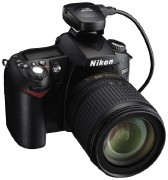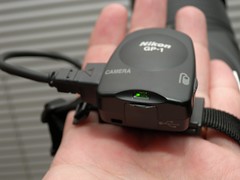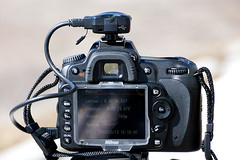Review: Nikon GP-1 GPS Unit
Introduction
For several years, I’ve been keeping half an eye on the GPS logger category — these are GPS receivers that record geographical coordinates that can later be applied to digital photos. But I never got around to trying one, probably because, as a Mac user, my options were slightly more limited (though Mac-compatible loggers are available), but mostly because the whole concept seemed too complicated.
You have to carry a separate device that records where you are at a given time, while you take pictures. Then you go home to your computer and sync up your GPS logs with the timestamps on your digital photos. A few more things to add to a photographer’s workflow, and if your camera’s clock doesn’t match the GPS satellite’s time, well, things can get messy. Far easier, I thought, to geotag my photos manually after the fact, I thought, especially since I could use Flickr’s relatively painless interface to drag and drop my photos onto a map.
Still, the idea was appealing, probably due to my interest in GPS, maps and navigation on the one hand, and my fast-developing interest in photography on the other.
Much more interesting to me were GPS units that plugged directly into your camera, writing latitude and longitude tags directly to the image file as you took your picture. That made a lot more sense to me, workflow-wise. But they were generally expensive, and for professional-grade digital SLRs. Above my pay scale.
My interest pricked up when consumer cameras with built-in GPS, like the Nikon Coolpix P6000, started to appear, but I’d already moved over to a consumer-level digital SLR.
 And then came the Nikon D90, which, when it was announced last summer, promised compatibility with a new GPS accessory that would not be shipping until November. At least as far as Nikon digital SLRs were concerned, it was the first consumer- or prosumer-level digital SLR with GPS compatibility. I was already thinking about upgrading to the D90; after nearly two years of noodling about with my D40, I was ready for a more powerful camera. GPS compatibility was more than icing on the cake — it helped tip the balance for me.
And then came the Nikon D90, which, when it was announced last summer, promised compatibility with a new GPS accessory that would not be shipping until November. At least as far as Nikon digital SLRs were concerned, it was the first consumer- or prosumer-level digital SLR with GPS compatibility. I was already thinking about upgrading to the D90; after nearly two years of noodling about with my D40, I was ready for a more powerful camera. GPS compatibility was more than icing on the cake — it helped tip the balance for me.
I bought my D90 in September, but waited until the end of December before I picked up that GPS accessory — the Nikon GP-1 GPS unit. At around $280 (Canadian), it wasn’t cheap, but then (a) Nikon accessories usually aren’t, and (b) neither are GPS units for digital SLRs. It took me a while to test it (it was a cold winter, and my health hasn’t been great, both of which conspired to keep me from running around taking photos outdoors), but I’m able to provide you with my review now.
Description
 As you can see from John Bielher’s photo at right, the GP-1 is small — much smaller than I expected. Short of a sync terminal adapter, it’s got to be the smallest thing you can attach to a camera’s hotshoe. But it doesn’t connect to the camera via the hotshoe: it’s there only for convenience’s sake (and possibly reception), and can be clipped instead to the camera strap (via a very flimsy adapter). Which is to say that you can use the GP-1 and an external flash at the same time.
As you can see from John Bielher’s photo at right, the GP-1 is small — much smaller than I expected. Short of a sync terminal adapter, it’s got to be the smallest thing you can attach to a camera’s hotshoe. But it doesn’t connect to the camera via the hotshoe: it’s there only for convenience’s sake (and possibly reception), and can be clipped instead to the camera strap (via a very flimsy adapter). Which is to say that you can use the GP-1 and an external flash at the same time.
 The GP-1 connects to the camera via one of two included cables: one to connect to the Nikon D90 through a unique accessory terminal used by the GP-1 (as well as the MC-DC2 wired remote), and another to attach to the 10-pin PC sync terminal on professional cameras. In either case, the GP-1 draws power from the camera through the cable; it has no batteries of its own.
The GP-1 connects to the camera via one of two included cables: one to connect to the Nikon D90 through a unique accessory terminal used by the GP-1 (as well as the MC-DC2 wired remote), and another to attach to the 10-pin PC sync terminal on professional cameras. In either case, the GP-1 draws power from the camera through the cable; it has no batteries of its own.
Apart from the D90, the GP-1 is fully compatible with the D3, D300 and D700; it also works with the D2X, D2XS, D2HS and D200, but those cameras lack an on-camera menu option to view GPS data. It does not work at all with the D40, D40X, D50, D60, D70, D70S or D80, which have no way of connecting to it, or with older pro digital SLRs like the D1 series or D100.
 The GP-1 has a pass-through port for the MC-DC2 remote so that you can use both at the same time. The MC-DC2 is specific to the D90, and plugs into the same terminal the GP-1 does; I don’t know if it can be used with other cameras when connected to the GP-1 (I wouldn’t count on it). There is no pass-through option for other PC terminal accessories, but I’m hard pressed to think of a situation that would require both GPS and, say, studio lighting or advanced wired remotes. You won’t be using a GPS in the studio; you’ll be using it in the field.
The GP-1 has a pass-through port for the MC-DC2 remote so that you can use both at the same time. The MC-DC2 is specific to the D90, and plugs into the same terminal the GP-1 does; I don’t know if it can be used with other cameras when connected to the GP-1 (I wouldn’t count on it). There is no pass-through option for other PC terminal accessories, but I’m hard pressed to think of a situation that would require both GPS and, say, studio lighting or advanced wired remotes. You won’t be using a GPS in the studio; you’ll be using it in the field.
Finally, there is also a USB port that allows the GP-1 to be connected to a computer via your camera’s USB cable; drivers are Windows-only (XP and Vista), so I haven’t been able to try this.
Use
 The GP-1 works automatically when the camera is turned on. A single LED indicates signal status: blinking red means that it has not acquired a GPS fix and data will not be recorded; blinking green means that it has acquired three GPS satellites and will record location data; solid green means that it has acquired four satellites, and location data will be more accurate.
The GP-1 works automatically when the camera is turned on. A single LED indicates signal status: blinking red means that it has not acquired a GPS fix and data will not be recorded; blinking green means that it has acquired three GPS satellites and will record location data; solid green means that it has acquired four satellites, and location data will be more accurate.
On recent cameras (the D90, D300, D700 and D3), you can also get GPS coordinates through the camera’s menus. On the D90, it’s under Setup Menu. If nothing else, it’s a quick and dirty way of figuring out your location if you have no other GPS on hand.
Testing
Unlike Richard, I have no prior experience with GPS loggers, so I was unsure how to go about testing the GP-1 — I had no baseline, no point of reference, to compare it with. All I could do, per his suggestion, was go out and take some photos and see how it performed.
Acquiring a GPS signal was sometimes tricky, particularly in the shadow of tall buildings or in river valleys. Since I don’t have much experience with GPS receivers, I can’t say whether this is typical, or better or worse than it should be. It could also take a few minutes, sometimes — the manual says it takes 45 seconds from a cold start, and can take a while if it’s been moved a great distance since the last time it was used. I didn’t time it, but my impression was that it was quicker than the GPS acquisition of my Celestron SkyScout, for what that’s worth.
Among high buildings, GPS lock faded in and out: I’d go from solid green to flashing red and back. Sometimes photos shot continuously would be geotagged intermittently — e.g., of three photos taken in a row, numbers one and three would be geotagged, but number two wouldn’t. I could test the signal lock by flicking the power switch to activate the LCD. In downtown Ottawa, I ended up doing that a lot.
The results of my test can be found on the map of this Flickr photoset. These are photos that the D90 successfully geotagged, most if not all at solid-green, four-satellite status. The photos were imported into Aperture and uploaded to Flickr; geodata was not fiddled with in any way.
The GP-1’s manual claims an accuracy of 10 metres; in many cases, it was better than that. In a couple of cases, the error was the equivalent of a few metres: essentially, it showed that I had taken the photo from the opposite side of the street than I actually did. All in all, quite satisfactory — and this is at the highest level of accuracy.
(There are several across-the-river shots in the set; remember that the GPS records where you’re standing, not what you’re taking a picture of. There can be a substantial difference between the two, as was the case in these shots.)
The GP-1’s draw on the camera’s power can be noticeable — I haven’t measured it, but I did notice that the battery was draining faster than I expected. If you’re using the GP-1 over an extended period, you may want to use a vertical grip battery pack (the MB-D80 for the D90, or the MB-D10 for the D300 or D700) if you’re not using a D3.
Verdict
The GP-1 works as advertised, with a useful level of accuracy. It’s considerably more expensive than other GPS loggers, but it makes up for that with its seamless integration with the cameras it’s compatible with. The basic question is, what’s more important to you: would you rather spend time to save money, with a more complicated, fiddlier GPS logger, or would you rather spend money to save time?
Previously: Nikon Digital SLR Geotagging Roundup; Another Nikon GP-1 Review; Nikon Geotagger Reviewed; Nikon’s Digital SLR Geotagger.
- Buy Nikon GP-1 GPS Unit at Amazon.com
- Buy Nikon MC-DC2 Remote at Amazon.com
- Buy Nikon D90 Digital SLR Camera with Kit Lens at Amazon.com
- Buy Nikon D90 Digital SLR Camera (Body Only) at Amazon.com

Comments
blog comments powered by Disqus